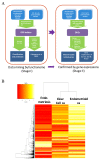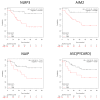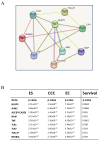Integrating the dysregulated inflammasome-based molecular functionome in the malignant transformation of endometriosis-associated ovarian carcinoma
- PMID: 29423077
- PMCID: PMC5790494
- DOI: 10.18632/oncotarget.23364
Integrating the dysregulated inflammasome-based molecular functionome in the malignant transformation of endometriosis-associated ovarian carcinoma
Abstract
The coexistence of endometriosis (ES) with ovarian clear cell carcinoma (CCC) or endometrioid carcinoma (EC) suggested that malignant transformation of ES leads to endometriosis associated ovarian carcinoma (EAOC). However, there is still lack of an integrating data analysis of the accumulated experimental data to provide the evidence supporting the hypothesis of EAOC transformation. Herein we used a function-based analytic model with the publicly available microarray datasets to investigate the expression profiling between ES, CCC, and EC. We analyzed the functional regularity pattern of the three type of samples and hierarchically clustered the gene sets to identify key mechanisms regulating the malignant transformation of EAOC. We identified a list of 18 genes (NLRP3, AIM2, PYCARD, NAIP, Caspase-4, Caspase-7, Caspase-8, TLR1, TLR7, TOLLIP, NFKBIA, TNF, TNFAIP3, INFGR2, P2RX7, IL-1B, IL1RL1, IL-18) closely related to inflammasome complex, indicating an important role of inflammation/immunity in EAOC transformation. We next explore the association between these target genes and patient survival using Gene Expression Omnibus (GEO), and found significant correlation between the expression levels of the target genes and the progression-free survival. Interestingly, high expression levels of AIM2 and NLRP3, initiating proteins of inflammasomes, were significantly correlated with poor progression-free survival. Immunohistochemistry staining confirmed a correlation between high AIM2 and high Ki-67 in clinical EAOC samples, supporting its role in disease progression. Collectively, we established a bioinformatic platform of gene-set integrative molecular functionome to dissect the pathogenic pathways of EAOC, and demonstrated a key role of dysregulated inflammasome in modulating the malignant transformation of EAOC.
Keywords: endometriosis; gene expression microarray; gene-set integrative analysis; inflammasome; ovarian carcinoma.
Conflict of interest statement
CONFLICTS OF INTEREST All authors declared no conflicts of interest.
Figures








Similar articles
-
Discovering the Deregulated Molecular Functions Involved in Malignant Transformation of Endometriosis to Endometriosis-Associated Ovarian Carcinoma Using a Data-Driven, Function-Based Analysis.Int J Mol Sci. 2017 Nov 6;18(11):2345. doi: 10.3390/ijms18112345. Int J Mol Sci. 2017. PMID: 29113136 Free PMC article.
-
Integrating modern approaches to pathogenetic concepts of malignant transformation of endometriosis.Oncol Rep. 2019 Mar;41(3):1729-1738. doi: 10.3892/or.2018.6946. Epub 2018 Dec 21. Oncol Rep. 2019. PMID: 30592289 Review.
-
Targeted next-generation sequencing for molecular diagnosis of endometriosis-associated ovarian cancer.J Mol Med (Berl). 2016 Jul;94(7):835-47. doi: 10.1007/s00109-016-1395-2. Epub 2016 Feb 27. J Mol Med (Berl). 2016. PMID: 26920370
-
RUNX3 is inactivated by promoter hypermethylation in malignant transformation of ovarian endometriosis.Oncol Rep. 2014 Dec;32(6):2580-8. doi: 10.3892/or.2014.3524. Epub 2014 Oct 3. Oncol Rep. 2014. PMID: 25333219
-
The recent progress and therapy in endometriosis-associated ovarian cancer.J Chin Med Assoc. 2020 Mar;83(3):227-232. doi: 10.1097/JCMA.0000000000000262. J Chin Med Assoc. 2020. PMID: 31985569 Review.
Cited by
-
Dysregulated Immunological Functionome and Dysfunctional Metabolic Pathway Recognized for the Pathogenesis of Borderline Ovarian Tumors by Integrative Polygenic Analytics.Int J Mol Sci. 2021 Apr 15;22(8):4105. doi: 10.3390/ijms22084105. Int J Mol Sci. 2021. PMID: 33921111 Free PMC article.
-
Genes' Interactions: A Major Contributor to the Malignant Transformation of Endometriosis.Int J Mol Sci. 2019 Apr 14;20(8):1842. doi: 10.3390/ijms20081842. Int J Mol Sci. 2019. PMID: 31013963 Free PMC article. Review.
-
NLRP3 Inflammasome Upregulates PD-L1 in Ovarian Cancer and Contributes to an Immunosuppressive Microenvironment.Immunotargets Ther. 2024 Dec 14;13:775-788. doi: 10.2147/ITT.S495564. eCollection 2024. Immunotargets Ther. 2024. PMID: 39703562 Free PMC article.
-
Withaferin A ameliorates ovarian cancer-induced cachexia and proinflammatory signaling.J Ovarian Res. 2019 Nov 25;12(1):115. doi: 10.1186/s13048-019-0586-1. J Ovarian Res. 2019. PMID: 31767036 Free PMC article.
-
Key Immunological Functions Involved in the Progression of Epithelial Ovarian Serous Carcinoma Discovered by the Gene Ontology-Based Immunofunctionome Analysis.Int J Mol Sci. 2018 Oct 24;19(11):3311. doi: 10.3390/ijms19113311. Int J Mol Sci. 2018. PMID: 30356023 Free PMC article.
References
-
- Brinton LA, Sakoda LC, Sherman ME, Frederiksen K, Kjaer SK, Graubard BI, Olsen JH, Mellemkjaer L. Relationship of benign gynecologic diseases to subsequent risk of ovarian and uterine tumors. Cancer Epidemiol Biomarkers Prev. 2005;14:2929–35. - PubMed
-
- Van Gorp T, Amant F, Neven P, Vergote I, Moerman P. Endometriosis and the development of malignant tumours of the pelvis. A review of literature. Best Pract Res Clin Obstet Gynaecol. 2004;18:349–71. - PubMed
-
- Fukunaga M, Nomura K, Ishikawa E, Ushigome S. Ovarian atypical endometriosis: its close association with malignant epithelial tumours. Histopathology. 1997;30:249–55. - PubMed
LinkOut - more resources
Full Text Sources
Other Literature Sources
Miscellaneous

